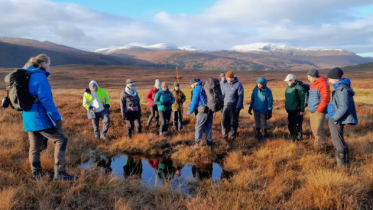Woodland expansion across Scotland
The Scottish Government’s vision is to expand our woodlands to cover 21% of Scotland’s land area by 2032.
Scotland has much less woodland cover than other countries in Europe, although it did increase in the 20th century. In 1900, only about 5% of Scotland’s land area was wooded. Large-scale afforestation had increased this figure to about 17% by the early 21st century.
The Scottish Government’s Draft Climate Change Plan, published in January 2017, proposes specific targets for future woodland expansion to cover 21% of Scotland by 2032. To deliver this, the draft plan proposes that the rate of new afforestation rises to 15,000 hectares per year by 2024.
Benefits of woodland expansion
Appropriate woodland expansion will bring more of the benefits that woodlands can provide:
- richer and more diverse habitats
- enhanced landscapes
- carbon sequestration and storage
- timber, wood fuel and other woodland products
- ecosystem services – such as clean water, mitigation of diffuse agricultural pollution, and reduced flood risk
- secure jobs and a stronger economy – both rural and national
Planning woodland expansion
It’s vital to carefully plan this woodland expansion. Scotland is a small country and much of our land is unsuitable for trees. A change this big will have a major impact on our landscape, wildlife, rural economy and carbon storage.
For example, woodland that improves habitat connectivity or provides high quality timber close to a good transport route will be very beneficial. But trees planted on deep peat may dry out, causing the soil to rapidly decompose. This may release more carbon than the trees take up.
Much of the expansion will take place on privately owned land, in line with the owners’ objectives. The Scottish Government can influence how and where expansion happens by providing incentives for woodland to be developed in the ways that most benefit society.
Incentives can help to ensure that new woodland:
- is created on the most suitable soils
- improves landscapes on degraded urban fringes
- provides habitats for wildlife
- mitigates diffuse pollution in watercourses
Find out about habitat networks and spatial ecology.
Work is also ongoing to consider how we can develop tools to help design woodland to provide ecosystem services - by reducing flood risk, filtering water to reduce pollution or helping to decontaminate land on brownfield sites.
Woodland expansion help and advice
Forestry and Land Scotland serves as the forestry directorate of the Scottish Government.
Woodland Trust promotes native woodland and offers free advice and support on woodland creation to a wide range of stakeholders.
Reforesting Scotland is a networking organisation for anyone active in the ecological and social regeneration of Scotland.
Trees for Life is the only organisation specifically dedicated to restoring the Caledonian Forest in the Scottish Highlands.
Community Woodlands Association represents Scotland’s community woodland groups and helps them to achieve their aims.
Native Woodlands Discussion Group is open to anyone interested in the ecology and management of native woodlands in northern Britain.





